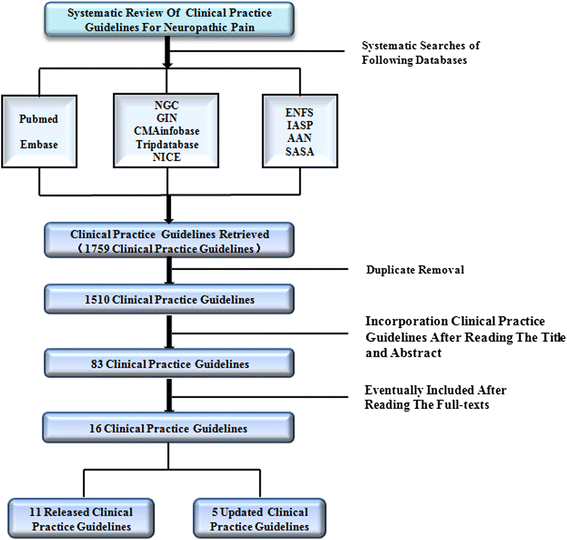Clinical practice guidelines for the management of neuropathic pain: a systematic review
- PMID: 26892406
- PMCID: PMC4759966
- DOI: 10.1186/s12871-015-0150-5
Clinical practice guidelines for the management of neuropathic pain: a systematic review
Abstract
Background: The management of neuropathic pain (NP) is challenging despite it being the recent focus of extensive research. A number of clinical practice guidelines (CPGs) for the management of NP have been published worldwide over the past 2 decades. This study aimed to assess the quality of these CPGs.
Methods: We performed a systematic review of published CPGs for the management of NP. Three reviewers independently assessed the quality of the CPGs using the Appraisal of Guidelines Research and Evaluation II (AGREE-II) instrument, and recommendations of CPGs were also appraised.
Results: A total of 16 CPGs were included. Thirteen CPGs were developed using an evidence-based approach, and the remaining CPGs were produced by consensus panels. None of CPGs obtained a score greater than 50% in all six AGREE II instrument domains mainly owing to poor performance in the "Applicability" domain. The highest score of the CPGs was achieved in "Clarity and Presentation" domain, followed by "Scope and Purpose" and "Editorial Independence" domains, and the lowest scores were found the in "Applicability" domain. The majority of the CPG recommendations on the management of patients with NP were relatively consistent, especially regarding the recommendation of stepwise treatment with medication.
Conclusions: Greater efforts are needed not only to improve the quality of development and presentation of the CPGs, but also to provide more efficacy evidence for the management of patients with NP.
References
-
- Graham R, Mancher M, Miller Wolman D, Greenfield S, Steinberg E, editors. Committee on standards for developing trustworthy clinical practice guidelines: Institute of Medicine. Clinical practice guidelines we can trust. Washington: National Academies Press; 2011. - PubMed
-
- Horvath AR, Nagy E, Watine J. Critical appraisal of guidelines. In: Price CP, Christenson RH, editors. Evidence-based laboratory medicine: principles, practice, outcomes. 2. Washington: AACC press; 2007. pp. 295–319.
-
- Ward JE, Grieco V. Why we need guidelines for guidelines: a study of the quality of clinical practice guidelines in Australia. Med J Aust. 1996;165:474–6. - PubMed
Publication types
MeSH terms
Substances
LinkOut - more resources
Full Text Sources
Other Literature Sources
Medical
Miscellaneous


